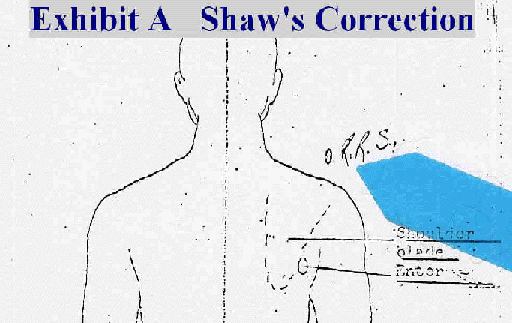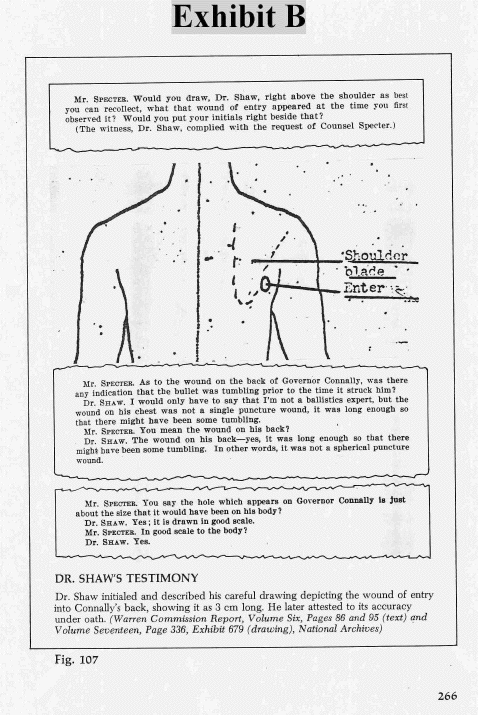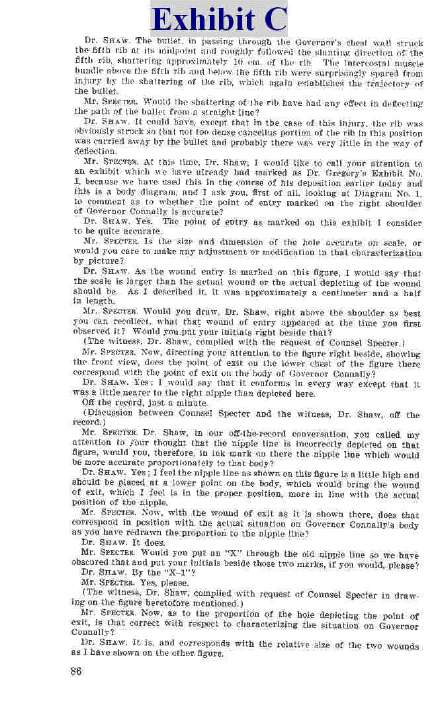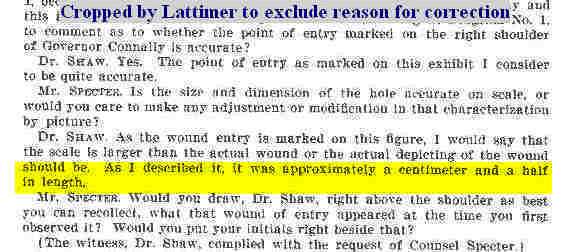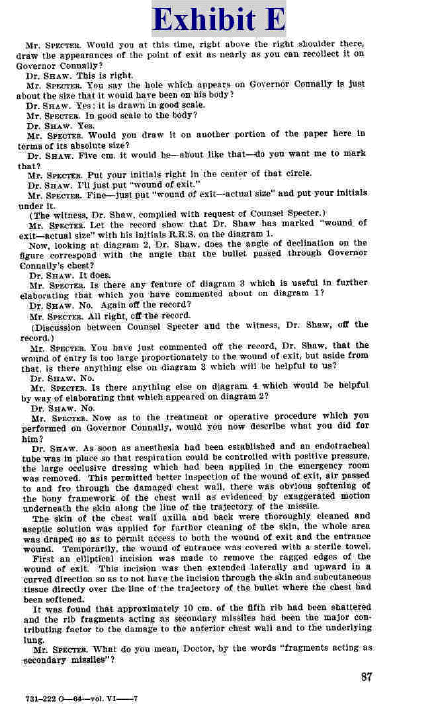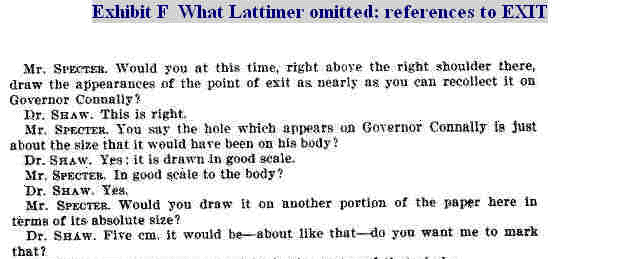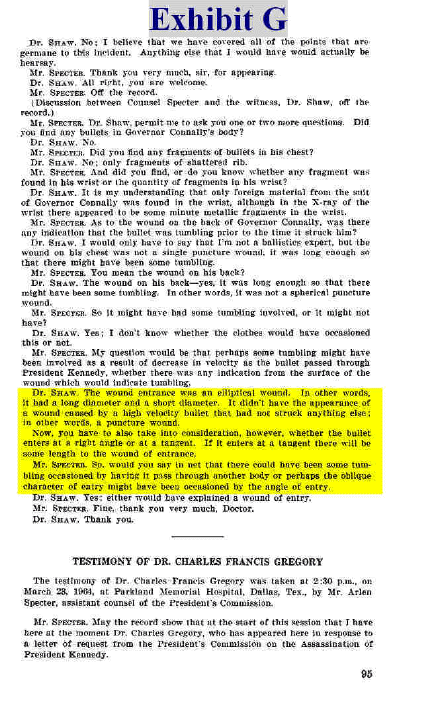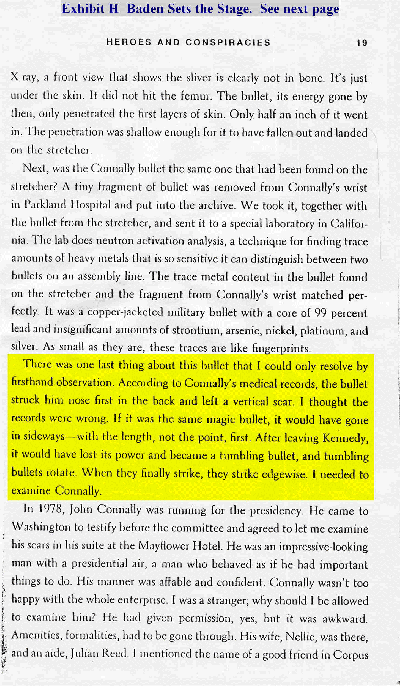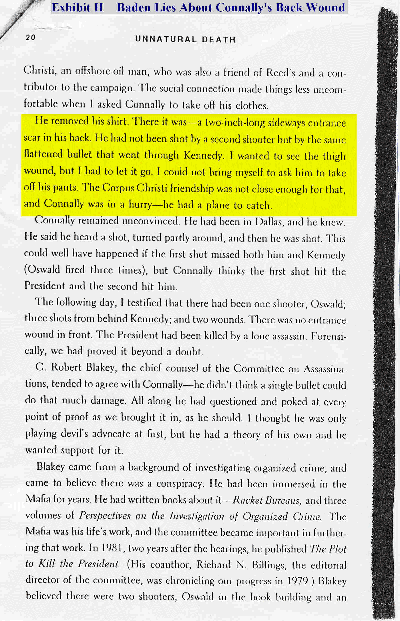Background
There is no evidence, hard or soft, that supports the single bullet theory. Its defenders spend a lot of "proving" it "could have happened that way" --- which is not the same as proving that it did, a distinction they don't make. But they can't even prove the SBT hypothetically because the sniper's nest and the various wounds of the two men do not line up. To solve this problem, promoters of the SBT resort to chicanery. And, in desperation, they squeeze great significance out of minutiae -- the small movements of Connally's jacket and hat -- events that occur all the time without the assistance of a bullet, magic or otherwise. Yet they ignore Connally's more dramatic movements that occur too late to be associated with the same bullet that hit JFK. Worse yet, they stoop to manufacturing evidence.
One example of manufactured evidence is the lie about Connally's back wound. Why do supporters of the SBT say the wound was 3 centimeters long, when, in fact, it was only half as long? Why was the 1.5 centimeter wound a problem? Defenders of the theory say that if the Carcano bullet had struck sideways (as opposed to nose-on), it would have created a wound the same size as its length (3 centimeters), and such a long wound would be proof the bullet had been tumbling. If it had been tumbling, this, presumably, would be proof it had struck something else on its way to Connally's back. The something else in this case: John F. Kennedy.
Problem: Connally's back wound was only as long as the wound in the back of Kennedy's head: 1.5 centimeters --- not a size that suggests the bullet was tumbling.
Adaptation of a drawing demonstrating the hypothetical tumbling bullet. From John Lattimer's book, Kennedy and Lincoln. Medical and Ballistic Comparisons of Their Assassinations, Harcourt Brace Jovanovich, 1980, page 268.
The drawing above demonstrates the alleged behavior of the single bullet. The drawing was designed (though not executed) by John Lattimer, a urologist who has published several infomercials in medical journals promoting the lone assassin theory. What is wrong with this picture, aside from the fact that the men are too far apart? Experts assure me the Carcano bullet is much too stable to behave like this. Perforating a neck could divert the bullet, but not make it tumble to this extent in so short a time and in so short a space. (There is more on Lattimer below.)
The wound in Connally's back did not indicate a sideways hit any more than the wound in the back of Kennedy's head. The latter was 1.5 x 0.6 centimeters, and the former, 1.5 x 0.8 centimeters, as documented on at least four occasions by the governor's thoracic surgeon, Dr. Robert Shaw. (4WCH104,107; 6WCH85,86). The holes in the back of Connally's shirt and jacket were as small as his back wound. (5WCH64) (See TABLE below.) The damage inside Connally's chest also disproves a sideways hit. According to Shaw, the bullet created a "small tunneling wound" (7HSCA149) and he noted, "the neat way in which it stripped the rib out without doing much damage to the muscles that lay on either side of it." (4WCH116) Shaw felt that the shape of the bullet was explained either by a "light tumbling," or by it striking at a tangent. (6WCH95) It had to have been a tangential hit since the bullet "followed the line of declination of the fifth rib" (4WCH105), i.e., its path slanted downward.
Connally's back wound became 3 centimeters when it was surgically enlarged. Shaw explained that in order to clean and debride (cut away devitalized tissue) the wound, he had to enlarge it to twice its size. (6WCH88)
Despite all this testimony, two doctors -- John Lattimer and Michael Baden -- found ways to make the magic bullet wound change its size to fit the magic bullet theory. And unethical "investigative journalists," like Gerald Posner, Gus Russo and Dale Myers, have spread the lie further.
John Lattimer Exploits a Coincidence
Bullets and wounds are a bit like keys and locks, and that would make John Lattimer an amateur locksmith. Since a tumbling bullet did not fit into Connally's back wound, Lattimer changed the lock.
Some 30 years ago, Lattimer noticed an interesting coincidence: the size of the wound -- after it was enlarged --- was the same length as a Carcano bullet, 3 centimeters. Lattimer then published an article in which he claimed the wound had been three centimeters long --- originally. (Medical Times 1974; 102 November:33-56; Kennedy and Lincoln, Harcourt Brace Jovanovich, 1980) As proof, he published Shaw's operative report that described the wound as "three cm" --- and never explained this was the size after surgical enlargement.
Lattimer also chose to publish an uncorrected diagram that portrayed the back wound as it was after surgical enlargement (CE 679, 17WCH336) when, instead, he could have published the corrected diagram showing the actual size of the wound (Gregory Exhibit No.1, 20WCH32). See Exhibits A and B.
On this same deceptive diagram, Lattimer pasted a snippet of testimony in which Shaw agrees the wound, as portrayed in the diagram, is correct --- but, omitted from this snippet were statements that made it clear Shaw was talking about the EXIT wound. Lattimer did report that a correction had been made, but lied about its nature: "His careful diagram of the wound of entry (which he revised and initialed) showed it to be elongated in its vertical (not horizontal) axis and to be at least 3 cm in length." (Medical Times 1974; 102 November:33-56; Kennedy and Lincoln, Harcourt Brace Jovanovich, 1980, page 266) See Exhibits B - F.
Lattimer included Shaw's testimony in which he agrees with Arlen Specter that the wound could have been caused by a slightly tumbling bullet --- but omitted Shaw's opinion that it could also have been caused by a tangential hit. (6WCH95) See Exhibit G. Again, it should be noted that this wound was the same length as the entrance into JFK's head, which supporters of the lone assassin theory say was a tangential hit.
Michael Baden Stretches the Lie Further
Dr. Michael Baden who headed the HSCA medical panel, knew the true size of the wound and how it had been enlarged. He had also personally examined the scar on Connally's back. This is how he described it to the panel:
"On removing his shirt, it was readily apparent that at the site of gunshot perforation of the upper right back there is now a 1 1/8 -inch long horizontal pale well healed..." (7HSCA 143-144; 240)
In a book Baden wrote for the public, he doubled the size of the scar:
"According to Connally's medical records, the bullet struck him nose first in the back and left a vertical scar. I thought the records were wrong. If it was the same magic bullet, it would have gone in sideways -- with the length, not the point, first. After leaving Kennedy, it would have lost its power and became a tumbling bullet, and tumbling bullets rotate. When they finally strike, they strike edgewise. I needed to examine Connally...
"He removed his shirt. There it was -- a two-inch long sideways entrance scar in his back. He had not been shot by a second shooter but by the same flattened bullet that went through Kennedy." (Unnatural Death: Confessions of a Medical Examiner, Random House 1989, p.20) See Exhibit H.
Apparently Baden realized that if the original wound had been three centimeters (1.2 inches), then, after its surgical enlargement, the scar would have been even bigger. It was a calculated lie. This is only one of several examples of Michael Baden's deceptions.
Gerald Posner, Gus Russo, and Dale Myers Perpetuate the Lie
Two of these "investigative reporters," Posner and Russo, never quoted primary sources on the wound, choosing instead to accept the fraudulent claims of Lattimer and Baden. (Gerald Posner. Case Closed. Random House, pp 336, 479; Gus Russo. Live by the Sword: The Secret War Against Castro and the Death of JFK. Bancroft Press, 1998, p.297).
The third "investigative reporter," Dale Myers, mimicked Lattimer's technique of taking testimony out of context. On his website, he wrote: "According to Dr. Robert Shaw's operative record, the entrance wound in JBC's body was 'just lateral to the right [shoulder blade] close [to] the [armpit] yet has passed through the latysmus [latissimus] dorsi muscle...the wound of entrance was approximately [1.2 inches] in its longest diameter.'" (7HSCA142) But Myers omitted what followed immediately after the quote above: "The rear entrance wound was NOT [emphasis mine] 3 centimeters [1.2 inches] (in diameter) as indicated in one of the operative notes. It was a puncture-type wound, as if a bullet had struck the body at slight declination [i.e., not at a right angle]. The wound was actually approximately 1.5 centimeters in diameter. The ragged edges of the wound were surgically cut away, effectively enlarging it to approximately 3 centimeters." (7HSCA143)
Conclusion
Five people, including the head of the second biggest investigation into the medical evidence, Michael Baden, MD, have demonstrated great faith in the public's inability or unwillingness to make a simple comparison between what they say, and what is a matter of public record.




